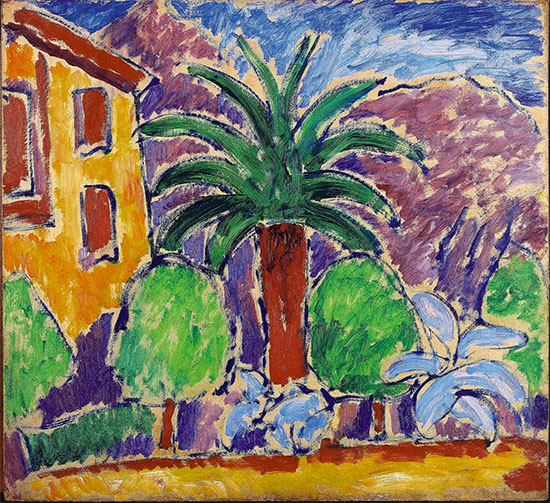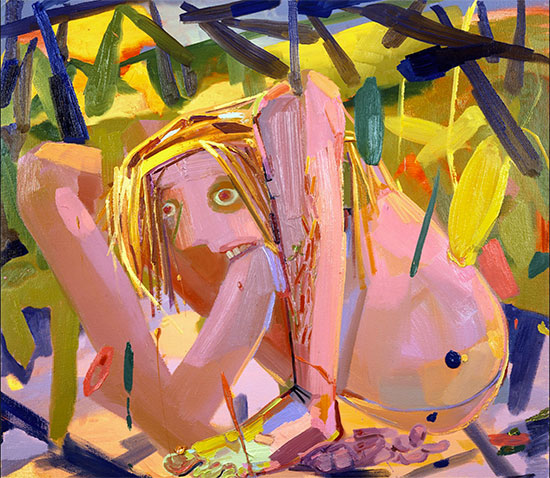The venerable TEFAF fair returns this week to the Park Avenue Armory with a blue-chip lineup of 93 galleries mainly dedicated to Modern and Contemporary art, along with a handful showing antiquities, design or African sculpture. The emphasis on art from the 20th century and later is a notable departure from the focus on European Old Masters in the fair’s fall iteration, when it arrived in New York riding its 30-year reputation from Maastricht, Netherlands.
With major works by such giants as Miro, Bacon, Delaunay, Leger, Picasso, Bourgeois and Fontana (who seems ubiquitous these days), it could be called a preview of the Old Masters fair a century from now. The talk of the trade at the preview on Wednesday was the importance of the unique TEFAF vetting process. With that kind of quality control in place, there was justifiable pride in the selectivity behind the fair.
As I don’t get to Maastricht as often as Manhattan, I used the Armory experience as a way to calibrate international tastes by dropping in primarily on the European and Asian galleries. The rewards began right near the Armory entrance, where deep inside the space of the Galerie Gmurzynska area (from Zurich) I found a small but densely packed Leger painting, Composition a la Feuille, that combined the landscape elements of his Cubist work (a bare tree that reminded me of his service in the trenches of the Argonne) with the outsized leaf forms of his still life paintings and a delicate scroll of paper that had traces of his tubular forms.
.

"Composition à la feuille" by Fernand Léger. Oil on Canvas, 19.69 x 25.59 inches. Exhibited with Galerie Gmurzynska. Courtesy of the gallery.
.
The heavy white impasto and delicate, busy strokes of the leaf were testimony to his academic training and expanding repertoire in 1931 when it was painted. It was one of the first treasures I found and remained a high point as I moved deeper into the Armory and upstairs (no visitor should skip the upper level). Just outside the Gmurzynska corner, it should be noted, is a towering work by Robert Delaunay, La Ville de Paris, that was brought by Dickinson Gallery of London and New York (their booth is upstairs). Despite its size it is easy to miss since most traffic flows away from it.
.

"La Ville de Paris, la Femme et la Tour Eiffel" by Robert Delaunay, 1925. Oil on two canvases in one frame, 118 x 37 inches and 59 x 37 inches. Exhibited with Simon Dickinson. Courtesy of the gallery.
.
At Munich’s Galerie Thomas, where I have often found paintings that are exuberantly colorful, I was not disappointed by a wall of Alexei Jawlensky works that included one unusual landscape in addition to the more typical brooding portraits. House with Palm Tree was painted in 1914 while the artist was enjoying the sun and gardens of Bordighera on the Ligurian coast, a favorite resort town for affluent Russians in that pre-revolution era. Jawlensky had only two weeks for his holiday, and all the pleasures of what he called the “feast of nature” are in this cheerful painting, its pink and purple fields and even the palm itself surrounded in an outline of Cezanne blue.
.

"House with Palm Tree" by Alexej von Jawlensky. Oil on cardboard on masonite, 19.8 x 21.3 inches. Exhibited with Galerie Thomas. Courtesy of the gallery.
.
I had to search hard for the masterpiece I had heard was coming to the show, because on its rough-hewn timber base it stands only about five feet tall but punches well above its height. The work is Baroque by Louise Bourgeois, a fascinatingly introspective marble sculpture she made in 1970 that coils what seem to be two or three figures (their heads help to orient the figural suggestion) in a huddled mass, rhythmically striated unlike many of the smoothly polished marble works I had seen.
This large and brilliant piece at the Galerie Karsten Greve space has cracks that were introduced by the artist running through many sides. Although heavy and crowded, it has some of the arching gesture of the artist’s spiders that have become so famous, but it is utterly unlike the attenuated vertical figures that dominate her sculpture. The provenance is flawless: Karsten Greve acquired it directly from the artist, with whom he worked frequently.
.

"Baroque" by Louise Bourgeois, 1970. Marble with a base of timber wood. Exhibited with Galerie Karsten Greve. Courtesy of the gallery.
.
Among the other highlights of the fair are: the solo show at Lisson Gallery (New York) devoted to Carmen Herrera’s Parisian paintings of the 1940s (her Whitney exhibition was reviewed for Hamptons Art Hub here); a superb group of Henry Moore drawings at Eykyn Maclean (from London); and the timely inclusion of Dana Schutz’s Self Eater at Petzel Gallery (New York) at a moment when Schutz’s controversial Emmett Till painting at the Whitney has been the talk of the town and the subject of an extensive profile in a recent New Yorker article by Calvin Tomkins.
.

"Self Eater" by Dana Schutz, 2003. Oil on canvas, 81.2 x 86.4 inches. Exhibited with Petzel Gallery. Courtesy of the gallery.
.
What makes TEFAF different from any other game in town is the rigorous vetting process, which is the foundation for the reputation of the mother fair at Maastricht. A committee of 194 experts divided into 29 categories, including Modern and Contemporary, checks provenance, attribution, condition and, most importantly, authenticity. As one veteran contemporary dealer from New York told me, on the condition of anonymity: “This is the game changer for us, the quality that comes with the vetting and sets this fair apart.”
Vetting provides confidence in authenticity and value at a time when the art market is vulnerable. A major exposé of fakes in the Modigliani market appeared in Vanity Fair just as the fair opened. It is telling that TEFAF has seen the need to train its gimlet eye on Contemporary art as well as Modern; from Warhol drawings to the “rediscovered” horde of Pollock paintings in an Islip warehouse, the need for vigilance is demonstrable.
In addition to the trained eyes (and gut reactions) of connoisseurs on the committee (most of them museum and conservation professionals) who make their living sorting the authentic from the ersatz, the process has gone high-tech, enlisting the scientific aid of Hirox digital microscopes, UV and infrared reflectography, direct digital radiography, and x-ray fluorescence portable spectrometers.
I was particularly struck by one firm assertion in the pre-fair press materials: “Modern and contemporary art is vetted to the exact same level as Old Masters.”
The Maastricht fair, where TEFAF made its name, has long been viewed as a haven in the Old Masters category, where the exposure of misattribution can zap a painting’s value with one blow, taking it from millions to zero in a moment. The stakes are all the higher since, as I have noticed recently as a critic and scholar, contemporary artists are now including appearances at fairs on their CVs. Vetting is part of what a business strategist would recognize as risk mitigation. Some of the blame for the situation can be laid at the door of greedy dealers and auction houses that have unashamedly peddled fakes, but there is also a global atmosphere of skepticism among consumers, who feel that the usual regulatory agencies lag behind the rascals, giving rise to the kind of voluntary self-policing that the TEFAF vetting committee exemplifies.
These are parlous times not just in the art trade, but in the larger world of commerce, particularly online where the controversy over the sale of fakes on Taobao, the Chinese merchandising giant, has undermined the company’s astonishing growth story, and engineers at Vokswagen have shaken the brand’s reputation. The lesson of TEFAF is the way the fair is taking steps to get out in front of a worldwide problem and offer visitors and buyers a sense of assurance that allows all to focus on the art itself without distractions, at least until the hors d’oeuvres and champagne come around.
______________________________
BASIC FACTS: TEFAF New York Spring Art Fair, May 4 to 8, 2017 at the Park Avenue Armory, 643 Park Avenue (at 68th Street), New York, NY 10065. www.tefaf.com.
______________________________
Copyright 2017 Hamptons Art Hub LLC. All rights reserved.
